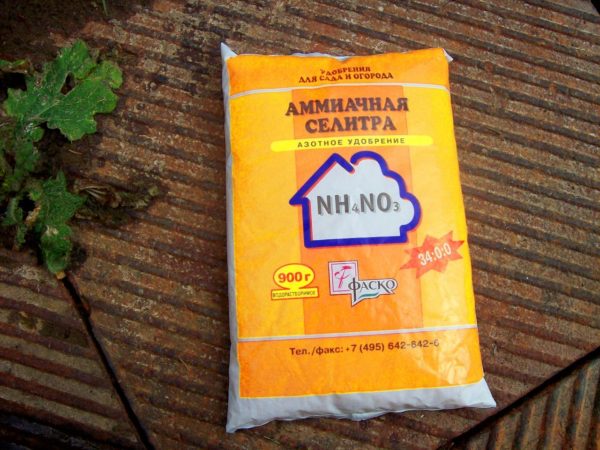Ammonium nitrate (other names: ammonium nitrate, ammonium nitrate, ammonium nitrate) is a chemical that is used in industry and agriculture. For farmers, this mineral nitrogen fertilizer. Many gardeners also began to apply such fertilizer in their garden. And to understand what it is, let's look at the composition of the substance and find out its benefits.
Table of contents
Types of saltpeter in gardening
Nitrate - special nitrogen compounds with different fertilizing properties. The most famous are:
- potassium
- calcium
- magnesium
- sodium
- ammonium lime
- ammonia
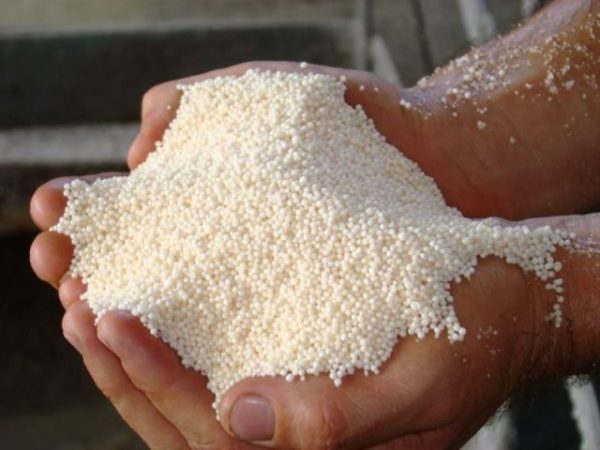
Types of ammonium nitrate
Ximikate is produced with marking “A” for industry, “B” - for agriculture. It is a bright crystals. In unsealed packaging, they quickly absorb moisture from the air and are compacted. To preserve the quality of the drug supply with special additives and form in the form of small spherical granules (white or yellowish).
Many firms offer granulated ammonium nitrate to gardeners: Bui fertilizers, Fusco, Fertika, Vika, BioMaster, etc. By weight, the packaging can be different.
Sometimes the drug is enriched with nutritional supplements: sulfur (azo sulphate), microelements (from "Fertic").
Special porous nitrate is used for the manufacture of explosives; It is prohibited for free sale.
Fertilizer application
Ammonium nitrate is used as a source of nitrogen for many cultivated plants: vegetable, fruit, berry, decorative (including pot plants), as well as siderats and on the lawn. Bring in the spring and in the first half of summer. The drug contributes to the active growth of young shoots, the development of a powerful sheet apparatus. Strong plants then bloom profusely and bear fruit.
A glass (200 ml) holds 240 g, a matchbox - 25 g, a tablespoon - 20 g, a teaspoon - 6 g.
- Under continuous spring plowing or digging, they pour 0.5 kg per 10 square meters. meters (depth seeding 10-20 cm). On fertile lands, the dose is halved. Under the autumn digging is not suitable.
- Immediately before planting, the granules are added to the wells and rows, mixing well with the ground. Dosage: 1 tsp. per well for seedlings, 2 tsp. - per running meter of row (onion, strawberry). With the spring planting of bushes and trees, from 20 to 200 g are placed on the planting pit (depending on the size of the seedling).
- In the spring or early summer, dry nitrate of nitrogen can be scattered over the surface of the earth - in a fruit garden. Dosage: 300 grams per 10 square meters. meters Do it once a season, just before a very heavy rain or abundant watering.
- Fertilizer irrigation is produced with a solution of ammonium nitrate (20-50 g per 10 liters of water - distributed over 10 sq. Meters). The lowest concentration is given to vegetables and flowers, medium - to bushes, high - to trees. The solution is applied 1-2 times during the first half of the season (for indoor, greenhouse and greenhouse plants, the terms may be different). After irrigation with fertilizer, it is imperative that you re-spill the earth with water.
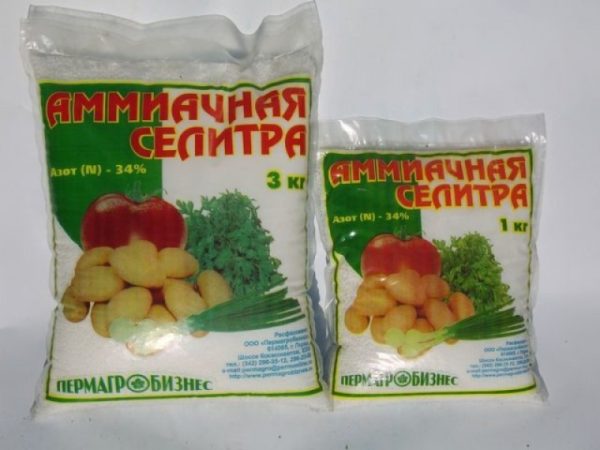
How much ammonium nitrate can be applied
- The frail seedling (of any crops) responds well to a single fertilizer irrigation (15-20 g per 10 l of water).
- Potatoes: 1) before planting 3 kg per hundred or 1 tsp per well; 2) in bulk before hilling (at the rate of 100 g per 10 sq. Meters) or watering in the budding phase (20 g per bucket - per 1 sq. Meter).
- Root crops, onions on a turnip, corn, grain beans: 1) 25-50 g per square meter for digging; 2) one liquid top dressing at the end of May or June (20 g per 10 l of water).
- Cabbage (except for early ripening): 1) per well 1 teaspoon; 2) 1-2 liquid supplements in June-July (30 g per 10 liters).
- Tomatoes, peppers, eggplants: 1) per well 1 teaspoon; 2) 1 fertilizer watering before flowering (15-30 g per 10 l).
- Strawberries: 1) 1 tbsp.spoon per linear meter when disembarking; 2) watering early in the spring (30 g per 10 liters); 3) watering in early August (the dose is the same).
- Raspberries: 1) when planting 1 tbsp. spoon in the hole; 2) watering in the spring (30 g per 10 l - per 1 adult bush).
- Fruit trees: two fertilizing irrigation (50 g per 10 l): immediately after flowering and then after a month (1 liter of solution per 1 sq. Meter of tree trunks).
- Flowers: 1) in the wells during spring planting (3-9 g each); 2) 1-2 watering before flowering (25 g per 10 l).
- Lawn: 3 irrigation from late April to mid-July (25 g per 10 liters per 1 sq. Meter).
- Siderates: presowing introduction and 1 fertilizing watering.
- Cucumbers, zucchini, pumpkins, melons: a single watering only at the stage before the flowering (30 g per 10 l).
Nitrate of nitrogen is perfectly soluble, therefore suitable for liquid application through the drip irrigation system.
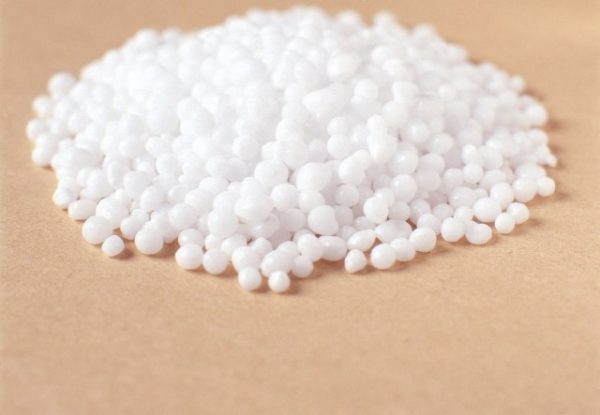
Potential harm to the garden
There are a number of hazards with the fertilizing application of ammonium nitrate.
- Burn leaves.It is not recommended to scatter the granules on the leaf and green grass, to make foliar dressings, to make a solution by sprinkling. It is better to pour under the root or overlap.
- Burn the roots.Do not exceed dosages. After fertilizer irrigation, it is necessary to spill the planting again - with ordinary water (or to time the event with rainy weather).
- Acidification of the soil.On acidic lands immediately after making the acidity rises a little more (research has shown that not for long).
- The accumulation of nitrates in the crop.It is forbidden to fertilize green cultures with ammonium nitrate (lettuce, onions on the feather, etc.), early cabbage, and early peas. Squashes, pumpkins, cucumbers, watermelons and melons are allowed to feed once a solution in the seedling period, not later.
Positive qualities of ammonium nitrate
- Low price.
- Excellent solubility.
- Acidification of alkaline soils.
- Ability to work in cold earth (spring).
- Loss of nitrogen in the soil is minimal, does not require deep sealing (in comparison with urea).
- Double action: both fast and long.
- The substance contains two nitrogen compounds: one penetrates the plants immediately, the other gradually. The remaining nitrogen fertilizers (urea, calcium nitrate, etc.) are absorbed more slowly. Only foliar urea absorption is also operative.
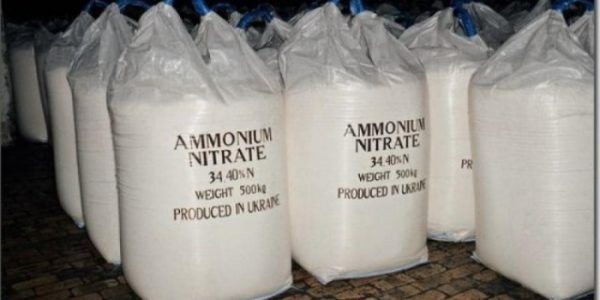
Alternative use in agriculture
- Strong solution is poured into stumps, and they quickly rot (no grunting is required).
- Concentrated solution moisten sawdust. So they perepryvat rather.
Mixing with other fertilizers
With what you can:
- potassium chloride and sulphate
- phosphate flour
What you can not:
- lime substances
- ash
- superphosphate
Shelf life
Guaranteed storage period is six months. After opening the factory packaging, it is advisable to use the drug during the season, for example in the fall.; then its fertilizing properties are reduced. In an airtight container (polyethylene) the chemical remains unchanged for many years. Well preserved also in glass jars with tight capron lids. It is very important to protect from moisture.
Precautionary measures
Ammonium nitrate has III class of danger, it is not poison. But you need to work with him fully clothed, with rubber gloves.
- In case of contact with wounds (itching pain), mucous membranes, eyes - the chemical is washed off for 15 minutes with running water.
- If (accidentally) ingestion may cause vomiting, dizziness. You should drink plenty of water, take activated charcoal, and seek medical help.
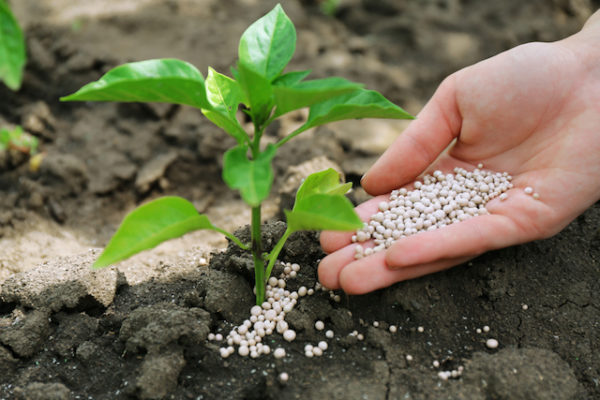
Under certain conditions, dry matter can ignite spontaneously and explode:
- from a sharp blow
- from fire, sparks, ashes
- in case of fire
- in contact with organic matter (sawdust, dry foliage, chips and bark, needles, peat, humus, etc.)
- in contact with sugar, acids, metal powder and chips
Safety regulations:
- Store the chemical separately from any other substances.
- Do not allow contamination.
- It is necessary to protect from blows. Clumpy lumps do not break, but dissolved in water.
- The storage should not be heated in the sun. Any sources of fire have no closer than 50 meters.
- Packaging is placed on a concrete, glass or polyethylene base (not on boards or metal).
In many countries, ammonium nitrate is banned for free sale. However, this drug is a cheap and effective nitrogen fertilizer. If you follow the simple rules of danger in gardening, he is not.
